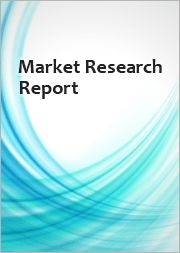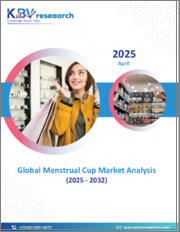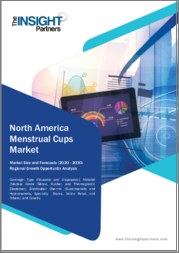
|
시장보고서
상품코드
1665969
생리컵 시장 규모, 점유율, 성장 분석 : 소재별, 형상별, 사이즈별, 사용성별, 유형별, 최종사용자별, 유통 채널별, 지역별 - 산업 예측(2025-2032년)Menstrual Cup Market Size, Share, and Growth Analysis, By Material (Medical grade silicones, Natural gum rubber ), By Shape, By Size, By Usability, By Type, By End-Users, By Distribution Channel, By Region - Industry Forecast 2025-2032 |
||||||
생리컵 시장 규모는 2023년에 25억 달러로, 2024년 26억 7,000만 달러에서 2032년에는 45억 6,000만 달러로 성장하며, 예측 기간(2025-2032년)의 CAGR은 6.9%로 성장할 전망입니다.
생리컵의 세계 시장은 생리컵의 많은 이점에 대한 여성들의 인식이 높아짐에 따라 그 인기가 크게 증가하고 있습니다. 수요를 촉진하는 주요 요인은 편의성, 저렴한 가격, 지속가능성, 편안함의 향상 등입니다. 기존 생리대 대안을 찾는 여성들이 증가함에 따라 보급률은 꾸준히 증가하고 있습니다. 제조업체들은 다양한 취향에 대응하기 위해 다양한 크기, 스타일, 소재의 제품을 다양화하여 대응하고 있습니다. 이러한 커스터마이징은 매출과 구매 의욕을 크게 높이고 있습니다. 또한 정부의 구상과 규제적 지원은 이러한 성장에 중요한 역할을 하고 있으며, 많은 국가에서 생리용품에 자금을 지원하고 접근성을 높이고, NGO와 건강 옹호 단체가 월경을 비종교화하고 친환경적인 선택을 장려하는 추세는 이러한 상승 추세를 더욱 강화할 것으로 보입니다. 생리컵이 많은 여성들에게 선호되는 선택이 되고 있습니다.
목차
서론
- 조사의 목적
- 조사 범위
- 정의
조사 방법
- 정보 조달
- 2차와 1차 데이터 방법
- 시장 규모 예측
- 시장의 전제조건과 제한
개요
- 세계 시장 전망
- 공급과 수요 동향 분석
- 부문별 기회 분석
시장 역학과 전망
- 시장 개요
- 시장 규모
- 시장 역학
- 촉진요인과 기회
- 억제요인과 과제
- Porter의 산업 분석
주요 시장 인사이트
- 주요 성공 요인
- 경쟁의 정도
- 주요 투자 기회
- 시장 에코시스템
- 시장의 매력 지수(2024년)
- PESTEL 분석
- 거시경제 지표
- 밸류체인 분석
- 가격 분석
생리컵 시장 규모 : 소재별
- 시장 개요
- 의료 등급 실리콘
- 천연 고무(라텍스)
- 열가소성 엘라스토머(TPE)
생리컵 시장 규모 : 형상별
- 시장 개요
- 벨형
- 원통형
- V자형
- 디스크 스타일
- 접이식
생리컵 시장 규모 : 사이즈별
- 시장 개요
- 소
- 중
- 대
생리컵 시장 규모 : 사용성별
- 시장 개요
- 재사용 가능
- 일회용
생리컵 시장 규모 : 유형별
- 시장 개요
- 환형
- 중공형
- 첨형
- 평형
생리컵 시장 규모 : 최종사용자별
- 시장 개요
- 병원
- 전문 클리닉
- 홈케어
- 기타
생리컵 시장 규모 : 유통 채널별
- 시장 개요
- 병원 약국
- 소매 약국
- 온라인 약국
- 기타
생리컵 시장 규모
- 북미
- 미국
- 캐나다
- 유럽
- 독일
- 스페인
- 프랑스
- 영국
- 이탈리아
- 기타 유럽 지역
- 아시아태평양
- 중국
- 인도
- 일본
- 한국
- 기타 아시아태평양
- 라틴아메리카
- 브라질
- 기타 라틴아메리카 지역
- 중동 및 아프리카
- GCC 국가
- 남아프리카공화국
- 기타 중동 및 아프리카
경쟁 정보
- 상위 5사의 비교
- 주요 기업의 시장 포지셔닝(2024년)
- 주요 시장 기업이 채택한 전략
- 최근 시장 동향
- 기업의 시장 점유율 분석(2024년)
- 주요 기업의 기업 개요
- 기업의 상세
- 제품 포트폴리오 분석
- 기업의 부문별 점유율 분석
- 매출의 전년대비 비교(2022-2024년)
주요 기업 개요
- Intimina(Sweden)
- Lunette(Finland)
- Diva International Inc.(Canada)
- Saalt Co.(USA)
- Me Luna(Germany)
- Yuuki(Czech Republic)
- Lena Cup(USA)
- OrganiCup(Denmark)
- FemmyCycle(USA)
- Mooncup Ltd(UK)
- Ruby Cup(Denmark/Kenya)
- Super Jennie(USA)
- SckoonCup(USA)
- Anigan USA(USA)
- Fleurcup(France)
- LadyCup(Czech Republic)
- Lily Cup(Sweden)
- Dutchess Cup(USA)
- Hello Cup(New Zealand)
- Merula(Germany)
결론과 제안
KSA 25.04.01Menstrual Cup Market size was valued at USD 2.5 billion in 2023 and is poised to grow from USD 2.67 billion in 2024 to USD 4.56 billion by 2032, growing at a CAGR of 6.9% during the forecast period (2025-2032).
The global market for menstrual cups has seen a significant rise in popularity, driven by increased awareness among women regarding their numerous benefits. Key factors fueling demand include convenience, affordability, sustainability, and enhanced comfort. As more women seek alternatives to traditional menstrual products, adoption rates are steadily climbing. Manufacturers have responded by diversifying their offerings with various sizes, styles, and materials that cater to varying preferences. This customization has boosted sales and engagement considerably. Additionally, government initiatives and regulatory support have played a crucial role in this growth, providing funding for menstrual health products in numerous countries and enhancing accessibility. Efforts by NGOs and health advocates to destigmatize menstruation and promote eco-friendly options further reinforce this upward trend, establishing menstrual cups as a preferred choice for many women.
Top-down and bottom-up approaches were used to estimate and validate the size of the Menstrual Cup market and to estimate the size of various other dependent submarkets. The research methodology used to estimate the market size includes the following details: The key players in the market were identified through secondary research, and their market shares in the respective regions were determined through primary and secondary research. This entire procedure includes the study of the annual and financial reports of the top market players and extensive interviews for key insights from industry leaders such as CEOs, VPs, directors, and marketing executives. All percentage shares split, and breakdowns were determined using secondary sources and verified through Primary sources. All possible parameters that affect the markets covered in this research study have been accounted for, viewed in extensive detail, verified through primary research, and analyzed to get the final quantitative and qualitative data.
Menstrual Cup Market Segments Analysis
Global Menstrual Cup Market is segmented by Material, Shape, Size, Usability, Type, End-Users, Distribution Channel and region. Based on Material, the market is segmented into Medical grade silicones, Natural gum rubber (Latex) and Thermoplastic elastomer (TPE). Based on Shape, the market is segmented into Bell Shaped, Cylindrical, V-Shaped, Disc-Style and Collapsible. Based on Size, the market is segmented into Small, Medium and Large. Based on Usability, the market is segmented into Reusable and Disposable. Based on Type, the market is segmented into Round, Hollow, Pointy and Flat. Based on End-Users, the market is segmented into Hospitals, Specialty Clinics, Homecare and Others. Based on Distribution Channel, the market is segmented into Hospital Pharmacy, Retail Pharmacy, Online Pharmacy and Others. Based on region, the market is segmented into North America, Europe, Asia Pacific, Latin America and Middle East & Africa.
Driver of the Menstrual Cup Market
The menstrual cup market is primarily driven by heightened environmental awareness among consumers, leading to a growing inclination toward sustainable products like reusable menstrual cups. As individuals become more conscious of the ecological impact of disposable menstrual products, which contribute significantly to waste, they are turning to alternatives that minimize litter. This shift in consumer behavior has resulted in a surge in popularity for reusable menstrual cups among women. By addressing both environmental concerns and the drawbacks associated with traditional menstrual products, reusable cups are gaining traction in the market as a more eco-friendly solution for menstrual care.
Restraints in the Menstrual Cup Market
The menstrual cup market faces significant restraints due to the societal stigma surrounding menstruation in many regions. In areas where traditional customs prevail and there is limited awareness of alternative menstrual products, women may feel discouraged from considering menstrual cups. This reluctance is often fueled by the shame associated with discussing menstruation openly, leading to hesitance in exploring disposable options. As a result, the lack of public conversation about menstrual health further exacerbates the challenges of introducing menstrual cups as a viable alternative, ultimately hindering their acceptance and usage among potential users. Overcoming these barriers is essential for market growth.
Market Trends of the Menstrual Cup Market
The Menstrual Cup market is experiencing a significant surge, driven by innovative product developments aimed at enhancing comfort, flexibility, and leak-proof capabilities. Companies are introducing advanced designs that allow for customizable sizes and shapes tailored to individual body types and varying flow levels, greatly increasing user satisfaction. These innovations not only address common concerns associated with traditional menstrual products but also encourage sustainable practices, as more women embrace reusable menstrual solutions. This trend towards personalized and eco-friendly options is reshaping consumer preferences, positioning menstrual cups as a preferable alternative in the evolving landscape of menstrual health products.
Table of Contents
Introduction
- Objectives of the Study
- Scope of the Report
- Definitions
Research Methodology
- Information Procurement
- Secondary & Primary Data Methods
- Market Size Estimation
- Market Assumptions & Limitations
Executive Summary
- Global Market Outlook
- Supply & Demand Trend Analysis
- Segmental Opportunity Analysis
Market Dynamics & Outlook
- Market Overview
- Market Size
- Market Dynamics
- Drivers & Opportunities
- Restraints & Challenges
- Porters Analysis
- Competitive rivalry
- Threat of substitute
- Bargaining power of buyers
- Threat of new entrants
- Bargaining power of suppliers
Key Market Insights
- Key Success Factors
- Degree of Competition
- Top Investment Pockets
- Market Ecosystem
- Market Attractiveness Index, 2024
- PESTEL Analysis
- Macro-Economic Indicators
- Value Chain Analysis
- Pricing Analysis
Global Menstrual Cup Market Size by Material & CAGR (2025-2032)
- Market Overview
- Medical grade silicones
- Natural gum rubber (Latex)
- Thermoplastic elastomer (TPE)
Global Menstrual Cup Market Size by Shape & CAGR (2025-2032)
- Market Overview
- Bell Shaped
- Cylindrical
- V-Shaped
- Disc-Style
- Collapsible
Global Menstrual Cup Market Size by Size & CAGR (2025-2032)
- Market Overview
- Small
- Medium
- Large
Global Menstrual Cup Market Size by Usability & CAGR (2025-2032)
- Market Overview
- Reusable
- Disposable
Global Menstrual Cup Market Size by Type & CAGR (2025-2032)
- Market Overview
- Round
- Hollow
- Pointy
- Flat
Global Menstrual Cup Market Size by End-Users & CAGR (2025-2032)
- Market Overview
- Hospitals
- Specialty Clinics
- Homecare
- Others
Global Menstrual Cup Market Size by Distribution Channel & CAGR (2025-2032)
- Market Overview
- Hospital Pharmacy
- Retail Pharmacy
- Online Pharmacy
- Others
Global Menstrual Cup Market Size & CAGR (2025-2032)
- North America (Material, Shape, Size, Usability, Type, End-Users, Distribution Channel)
- US
- Canada
- Europe (Material, Shape, Size, Usability, Type, End-Users, Distribution Channel)
- Germany
- Spain
- France
- UK
- Italy
- Rest of Europe
- Asia Pacific (Material, Shape, Size, Usability, Type, End-Users, Distribution Channel)
- China
- India
- Japan
- South Korea
- Rest of Asia-Pacific
- Latin America (Material, Shape, Size, Usability, Type, End-Users, Distribution Channel)
- Brazil
- Rest of Latin America
- Middle East & Africa (Material, Shape, Size, Usability, Type, End-Users, Distribution Channel)
- GCC Countries
- South Africa
- Rest of Middle East & Africa
Competitive Intelligence
- Top 5 Player Comparison
- Market Positioning of Key Players, 2024
- Strategies Adopted by Key Market Players
- Recent Developments in the Market
- Company Market Share Analysis, 2024
- Company Profiles of All Key Players
- Company Details
- Product Portfolio Analysis
- Company's Segmental Share Analysis
- Revenue Y-O-Y Comparison (2022-2024)
Key Company Profiles
- Intimina (Sweden)
- Company Overview
- Business Segment Overview
- Financial Updates
- Key Developments
- Lunette (Finland)
- Company Overview
- Business Segment Overview
- Financial Updates
- Key Developments
- Diva International Inc. (Canada)
- Company Overview
- Business Segment Overview
- Financial Updates
- Key Developments
- Saalt Co. (USA)
- Company Overview
- Business Segment Overview
- Financial Updates
- Key Developments
- Me Luna (Germany)
- Company Overview
- Business Segment Overview
- Financial Updates
- Key Developments
- Yuuki (Czech Republic)
- Company Overview
- Business Segment Overview
- Financial Updates
- Key Developments
- Lena Cup (USA)
- Company Overview
- Business Segment Overview
- Financial Updates
- Key Developments
- OrganiCup (Denmark)
- Company Overview
- Business Segment Overview
- Financial Updates
- Key Developments
- FemmyCycle (USA)
- Company Overview
- Business Segment Overview
- Financial Updates
- Key Developments
- Mooncup Ltd (UK)
- Company Overview
- Business Segment Overview
- Financial Updates
- Key Developments
- Ruby Cup (Denmark/Kenya)
- Company Overview
- Business Segment Overview
- Financial Updates
- Key Developments
- Super Jennie (USA)
- Company Overview
- Business Segment Overview
- Financial Updates
- Key Developments
- SckoonCup (USA)
- Company Overview
- Business Segment Overview
- Financial Updates
- Key Developments
- Anigan USA (USA)
- Company Overview
- Business Segment Overview
- Financial Updates
- Key Developments
- Fleurcup (France)
- Company Overview
- Business Segment Overview
- Financial Updates
- Key Developments
- LadyCup (Czech Republic)
- Company Overview
- Business Segment Overview
- Financial Updates
- Key Developments
- Lily Cup (Sweden)
- Company Overview
- Business Segment Overview
- Financial Updates
- Key Developments
- Dutchess Cup (USA)
- Company Overview
- Business Segment Overview
- Financial Updates
- Key Developments
- Hello Cup (New Zealand)
- Company Overview
- Business Segment Overview
- Financial Updates
- Key Developments
- Merula (Germany)
- Company Overview
- Business Segment Overview
- Financial Updates
- Key Developments



















